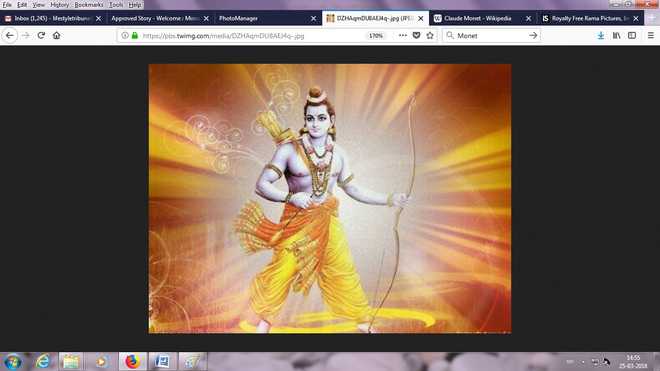Dr Satish K Kapoor
Lord Rama is the conscience of India, the fulcrum of its virtues. He is regarded as both nara, human and narayana, divine, saguna, with attributes, and nirguna, without attributes. He is maryada purushottama, the model of human excellence, and the personification of dharma, righteousness.
The Ramayana of sage Valmiki, presents him as an ideal, divinely human in his acts. The Adhyatama Ramayana portrays him as a saviour god. The Ramacharitamanasa of Goswami Tulsidasa, describes him as both man and god. The Mahabharata (Vana parva) refers to him as a seasoned warrior-prince. Minor Upanishads like Ramarahasya and Ramapurvatapaniya depict him as the Supreme deity.
The Hindus do not regard Rama as merely a benevolent monarch of Ayodhya, or as a friend of gods who defeated the demon king, Ravana, but as the seventh incarnation of the Lord Vishnu. He is for them the ideal, the way and the Ultimate Goal. His life has inspired poets and politicians, philosophers and artists, kings and common men alike. The story of his wanderings and exploits has been told and retold in every Hindu home since time immemorial.
Lord Rama was born on chaitra shukla navami, the ninth day of the bright half of the Hindu lunar month of Chaitra (March – April) in the constellation named Punarvasu. The dominance of moon and Jupiter in the Lagna in Karka Rashi, the ascendance of Saturn in the 4th house and the exalted position of Mars and Sun in the seventh and tenth houses, respectively, clearly show that he was an extraordinary person.
He helped the sage Vishwamitra in eliminating the demons who had created terror in the areas lying between the rivers Sarayu and the Ganga, slew the ogress Taraka and defeated her son Maricha, broke the magical bow of Shiva and won Sita, daughter of King Janaka of Mithila, from a svayamvara, pacified the furious Parshurama, raised Ahalya from a stone-block, relished plums offered by Shabari, a low-caste woman, foiled the immoral designs of Shurpanakha, defeated Khar and Dushan, killed Bali and restored to Sugriva his kingdom, constructed a setu, bridge, to reach Lanka and defeated Ravana, proclaimed Vibhishana as king and returned to Ayodhya where he received a warm welcome and was coronated. His sense of justice, veneration of holy men, and concern for the welfare of people endeared him to everyone.
The earliest reference to Lord Rama’s life occurs in a Buddhist Jataka from which the saga Valmiki is said to have derived some of his material for the Ramayana. As the legend goes, Valmiki once asked Narada, who among the heroes of the world was the highest in virtue and wisdom? The answer came that he was Rama, a descendant of the solar dynasty. Later, one day, as the sage walked along the riverbank he saw coupling birds shot by a hunter. He felt so grieved that his feelings burst forth into metrical speech. Lord Brahma then asked him to compose the life of Rama in verse.
The simplicity of style of Valmiki’s Ramayana and the absence of any reliable allusion to Buddhism, show that a great portion, if not the whole of the Ramayana was current in India as early as 5th century B. C. In its present form, the epic has about 24, 000 stanzas which are spread out in seven kanda or books.
It is sometimes argued that the story of Rama represents an ideal and not a form. Some scholars identify Rama with the Egyptian god Ra. Others draw points of similarity between the Ramayana and the Iliad of Homer.
The story of Lord Rama has influenced Peruvian and Nepalese poetry, Cambodian sculpture, Indonesian architecture, Malaysian plays, Sinhalese novels and Laotian paintings. One reason for the popularity of Lord Rama is his immaculate character. The legends about his life have retained their purity, unlike some other deities.
(Dr Satish K Kapoor, former British Council Scholar, is a noted educationist, historian and spiritualist)










